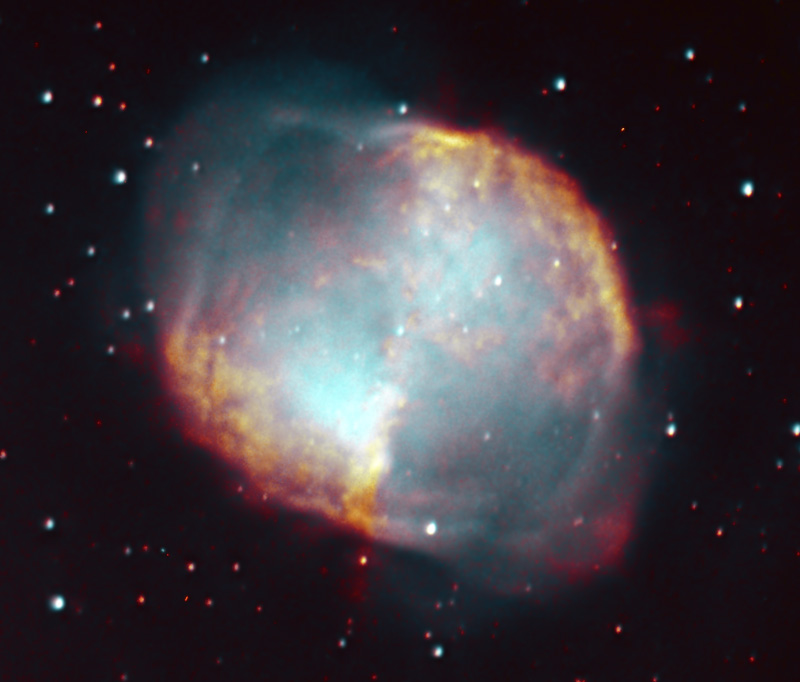

Image centered on Ra. 19 : 59.6 (h:m) Dec.+22 : 43 (deg:m) Distance 1250 Ly
Planetary Nebula M27 (NGC 6853), type 3a+2, in Vulpecula
Information (from the SEDS online website)
Discovered by Charles Messier in 1764.
The Dumbbell Nebula M27 was the first planetary nebula ever discovered. On July
12, 1764, Charles Messier discovered this new and fascinating class of objects,
and describes this one as an oval nebula without stars. The name "Dumb-bell"
goes back to the description by John Herschel, who also compared it to a
"double-headed shot."
We happen to see this one approximately from its equatorial plane (approx.
left-to-right in our image); this is similar to our view of another, fainter
Messier planetary nebula, M76, which is called the Little Dumbbell. From near
one pole, it would probably have the shape of a ring, and perhaps look like we
view the Ring Nebula M57.
This planetary nebula is certainly the most impressive object of its kind in the
sky, as the angular diameter of the luminous body is nearly 6 arc minutes, with
a faint halo extensing out to over 15', half the apparent diameter of the Moon (Millikan
1974). It is also among the brightest, being at most little less luminous with
its estimated apparent visual magnitude 7.4 than the brightest, the Helix Nebula
NGC 7293 in Aquarius, with 7.3, which however has a much lower surface
brightness because of its larger extension (estimates from Stephen Hynes); it is
a bit unusual that this planetary is only little fainter photographically (mag
7.6). The present author (hf) was surprized how fine this object was seen in his
10x50 binoculars under moderately good conditions !
As measured by Soviet astronomer O.N. Chudowitchera from Pulkowo (and mentioned
by L.H. Aller, Glyn Jones and Vehrenberg), the bright portion of the nebula is
apparently expanding at a rate of 6.8 arc seconds per century, leading to an
estimated age of 3,000 to 4,000 years, i.e. the shell ejection probably would
have been observable this time ago (it actually happened earlier as the light
had to travel all the distance of perhaps about 1000 light years). She estimated
the distance somewhat short at only about 490 ly. Another estimate, given by
Burnham, has obtained a rate 1.0 arc seconds per century, and an estimated age
of 48,000 years.
The central star of M27 is quite bright at mag 13.5, and an extremely hot
blueish subdwarf dwarf at about 85,000 K (so the spectral type is given as O7 in
the Sky Catalog 2000). K.M. Cudworth of the Yerkes Observatory found that it
probably has a faint (mag 17) yellow companion at 6.5" in position angle 214 deg
(Burnham).
As for most planetary nebulae, the distance of M27 (and thus true dimension and
intrinsic luminosity) is not very well known. Hynes gives about 800, Kenneth
Glyn Jones 975, Mallas/Kreimer 1250 light years, while other existing estimates
reach from 490 to 3500 light years. Currently, investigations with the Hubble
Space Telescope are under work to determine a more reliable and acurate value
for the distance of the Dumbbell Nebula.
Adopting our value of 1200 light years, the intrinsic luminosity of the gaseous
nebula is about 100 times that of the Sun (about -0.5 Mag absolute) while the
star is at about +6 (1/3 of the Sun) and the companion at +9..9.5 (nearly 100
times fainter than the Sun), all in the visual light part of the electromagnetic
spectrum. That the nebula is so much brighter than the star shows that the star
emits primarily highly energetic radiation of the non-visible part of the
electro-magnetic spectrum, which is absorbed by exciting the nebula's gas, and
re-emitted by the nebula, at last to a good part in the visible light. Actually,
as for almost all planetary nebulae, most of the visible light is even emitted
in one spectral line only, in the green light at 5007 Angstrom
Optics and Exposure Data
Telescope Celestron 9.25 SCT operating at f6.3 with a Meade focal Reducer
Imager Starlite-Xpress SXV-H9 Using Astronomiks RGB filters
Mount Losmandy G11 with Gemini Control Electronics.
90 minutes Ha, 90 minutes OIII. Ha and OIII blended using Steve Cannistra's synthetic green channel method.
Image acquisition using Astroart then aligned and combined with Maxim Dl. Final processing was accomplished using Photoshop Cs
Images acquired from my backyard - " Dirt Clod Observatory" in Antelope California